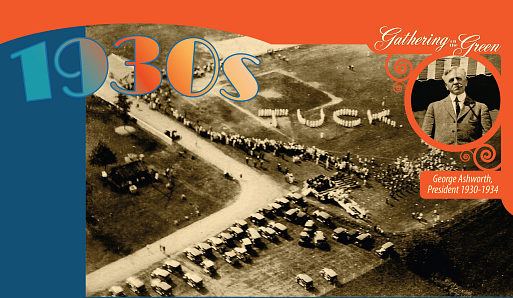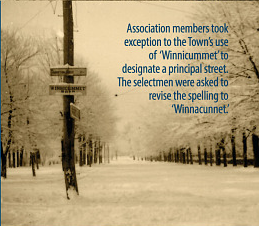
1930s

|

|

|

 After John Bradbury's death in 1935 the Town assumed the care of Memorial Park. The new custodian, Alice Taylor, paid a yearly rent of $240 in exchange for opening the 'Historical Room' to visitors on Wednesday and Saturday afternoons from May to October. Volunteer member Emily Hutchings took charge of the room and its growing historical collection. Tuck Field was dedicated, committees were selected to 'further historical interest,' copies of Edmund W. Toppan's History were made and distributed, and it was voted to hold annual meetings as close to October 14 as possible.
Committees planned for the Tercentenary celebration in 1938, and that year the Taylor and Weare family stones were added to Memorial Park. The records noted that Bernice Palmer's commemorative scrapbook of the Tercentenary events was 'very complete...and since it will be invaluable in years to come, it is not to be taken from the historical rooms.'
Historians were Caroline Shea (1931-1932), Lucy Marston (1932-1934), Sarah Lane (1934-1938), and Annie True (1938-1940).
Other Presidents were Howard G. Lane (1934-1935), Herbert Walker (1935-1940)
Prayer and singing of patriotic songs opened every meeting. With formality in modes of address, personal titles were always used. Speakers lectured on the value of emulating Puritan virtues, conservatism, and pioneering spirit. At the 15th annual meeting, which capped the decade, members granted the elected officers the authority to determine the 'future care and upkeep' of the Museum and grounds.
After John Bradbury's death in 1935 the Town assumed the care of Memorial Park. The new custodian, Alice Taylor, paid a yearly rent of $240 in exchange for opening the 'Historical Room' to visitors on Wednesday and Saturday afternoons from May to October. Volunteer member Emily Hutchings took charge of the room and its growing historical collection. Tuck Field was dedicated, committees were selected to 'further historical interest,' copies of Edmund W. Toppan's History were made and distributed, and it was voted to hold annual meetings as close to October 14 as possible.
Committees planned for the Tercentenary celebration in 1938, and that year the Taylor and Weare family stones were added to Memorial Park. The records noted that Bernice Palmer's commemorative scrapbook of the Tercentenary events was 'very complete...and since it will be invaluable in years to come, it is not to be taken from the historical rooms.'
Historians were Caroline Shea (1931-1932), Lucy Marston (1932-1934), Sarah Lane (1934-1938), and Annie True (1938-1940).
Other Presidents were Howard G. Lane (1934-1935), Herbert Walker (1935-1940)
Prayer and singing of patriotic songs opened every meeting. With formality in modes of address, personal titles were always used. Speakers lectured on the value of emulating Puritan virtues, conservatism, and pioneering spirit. At the 15th annual meeting, which capped the decade, members granted the elected officers the authority to determine the 'future care and upkeep' of the Museum and grounds.
